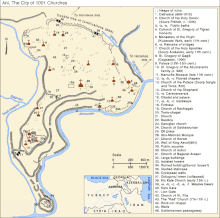Siege of Ani (1124)
| Siege of Ani | |||||||
|---|---|---|---|---|---|---|---|
 Plan of Ani | |||||||
| |||||||
| Belligerents | |||||||
|
| Shaddadids | ||||||
| Commanders and leaders | |||||||
|
| Abu'l-Aswar Shavur ibn Manuchihr | ||||||
| Strength | |||||||
| 60,000 | Unknown | ||||||
The Siege of Ani (Georgian: ანისის ალყა) took place in 1124, which the Georgian army under the command of David IV the Builder liberated the ancient capital of Armenia, the city of Ani, from the Muslim emirs.[1]
Background[edit]
Ani had been in Muslim hands since its capture by Alp Arslan in 1064 and a forced Islamization of the city had taken place since the sale of Ani to the Shaddadids, to the discontent of the local Christian population.[2]
The city of Ani was an important economic center of the Near East, during this period it was owned by Abu'l-Aswar, who succeeded his father Manuchar in 1118.[3]
Abu'l-Aswar persecuted the Christians and tried to sell Ani to the emir of Kars[4] (he was a Seljuk) for 60,000 dinars, he also placed a crescent on the dome of the Cathedral of Ani.[5][6]
Naturally, this kind of action of Abulaswar caused a lot of grief to the people of Ani. Armenians decided to turn to the king of Georgia for help.
Siege[edit]
David the Builder gathered 60,000 horsemen in three days and marched towards Ani. Without a single fight, the Armenians of Ani opened the gates to the Georgians. Samuel Anetsi notes that "not a single soul was harmed by blood". David capture emir Abu'l-Aswar Shavur ibn Manuchihr (r. 1118-1124) and exiled him and his family to Abkhazia.[3]
The king of Georgia freed the Cathedral of Ani, which had been turned into a shrine. Katranide, the queen of the Greeks who built the Cathedral, was buried there. David, together with the Catholicos and the bishops, took care of the deceased and called the tomb three times "Rejoice, you holy queen, for God has saved your throne from the hands of the unrighteous."[7]
David annexed Ani and its neighboring country to the Kingdom of Georgia and left Meskhi nobles as guards. According to Vardan Bazberdets, the king left the Georgian nobles Abuleti and his son Ivane as governors of Ani, then David conquered the districts located in the Vanand and Ararat provinces, which once belonged to the Armenian kings Kvirike and Abbas, as well as the countries up to the Caspian Sea in the Atsakh province of Khabanda Greater Armenia and others.[7]
References[edit]
- ^ Pubblici 2022, p. 20.
- ^ René Grousset (1947). Histoire de l'Arménie des origines à 1071. Paris: Payot. p. 615. ISBN 978-2-228-88912-4..
- ^ a b Metreveli 2011, p. 113.
- ^ Peacock 2011.
- ^ Hasratyan 2002.
- ^ "The Cathedral of Ani". virtualani.org. Virtual Ani. Archived from the original on 7 April 2016.
- ^ a b Metreveli 2011, p. 114.
Bibliography[edit]
- Hasratyan, Murad (2002). "Անիի Մայր Տաճար (Cathedral of Ani)". In Ayvazyan, Hovhannes (ed.). "Քրիստոնյա Հայաստան" հանրագիտարան ("Christian Armenia" Encyclopedia) (in Armenian). Armenian Encyclopedia Publishing. pp. 63–64.
- Pubblici, Lorenzo (2022). Mongol Caucasia: Invasions, Conquest, and Government of a Frontier Region in Thirteenth-Century Eurasia (1204-1295). Brill.
- Metreveli, Roin (2011). Saint David the Builder. Tbilisi. ISBN 9789941425509.
{{cite book}}: CS1 maint: location missing publisher (link)[permanent dead link] - Peacock, Andrew (2011). "Shaddadids". Encyclopædia Iranica.
